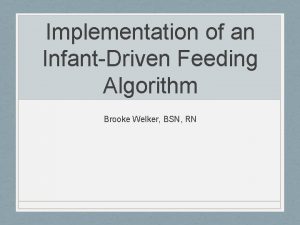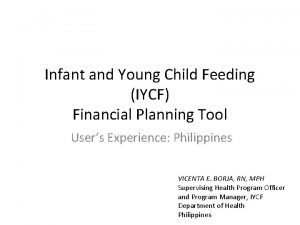Country years Infant Young Child Feeding IYCF Infant


- Slides: 2

Country year(s) Infant & Young Child Feeding (IYCF) Infant & Young Child Feeding Start Breastfeeding within one hour of birth Provide nutritionally adequate, age appropriate and safely prepared complementary foods starting at 6 months; and continue breastfeeding until age 2 or longer Breastfeed exclusively for the first 6 months of life <1 hour Early initiation 0 -5 months Exclusive 6 -8 months Introduction of solid, 6 -23 months Minimum meal of breastfeeding semi-solid or soft food frequency 6 -23 months Minimum diet diversity 6 -23 months Minimum acceptable diet 12 -15 months 20 -23 months Continued breastfeeding at 1 year at 2 years 100 Percent 80 67 60 51 45 40 40 40 25 21 22 Introduction of solid, semi-solid or soft foods Minimum meal frequency 20 0 Early Initiation of breastfeeding Exclusive breastfeeding Minimum diet diversity Minimum acceptable diet Continued breastfeeding at 1 year Continued breastfeeding at 2 years Early initiation: percentage of newborns put to breast within 1 hour of birth; Exclusive breastfeeding: percentage of infants aged 0 -5 months receiving only breastmilk; Introduction to solids: percentage of infants aged 6 -8 months receiving solid or semi-solid food; Minimum diet diversity: percentage of children aged 6 -23 months receiving 5 of the 8 recommended food groups; Minimum meal frequency: percentage of children aged 6 -23 months receiving the recommended minimum number of solid/liquid feeds as per the age of child; Minimum acceptable diet: percentage of children aged 6 -23 months receiving the minimum diversity of foods and minimum number of feeds; Continued breastfeeding at 1 year: percentage of children aged 12 -15 months who continue to receive breastmilk; Continued breastfeeding at 2 years: percentage of children aged 20 -23 months who continue to receive breastmilk. Key Messages • • • Lorem ipsum dolor sit amet, consectetuer • adipiscing elit, Lorem ipsum dolor sit amet, consectetuer adipiscing elit, sed diam nonummy nibh euismod tincidunt ut laoreet dolore • magna aliquam erat volutpat. Ut wisi enim ad minim veniam, quis nostrud exerci tation ullamcorper suscipit lobortis nisl ut aliquip ex ea commodo consequat. Duis autem vel eum iriure dolor in hensed diam Lorem ipsum dolor sit amet, consectetuer adipiscing elit, sed diam nonummy nibh • euismod tincidunt ut laoreet dolore magna aliquam erat volutpat. Ut wisi enim ad minim veniam, quis nostrud exerci tation ullamcorper suscipit lobortis nisl ut aliquip ex ea commodo consequat. Duis autem vel eum iriure dolor in hennonummy nibh euismod tincidunt ut laoreet dolore magna aliquam erat volutpat. Ut wisi enim ad minim veniam, quis nostrud exerci tation ullamcorper suscipit lobortis nisl ut aliquip ex ea commodo consequat. Duis autem vel eum iriure dolor in hen

IYCF: Equity Minimum Diet Diversity Early Initiation of Breastfeeding National 100 80 80 60 [CELLRANGE], [CELLRANGE], [VALUE] [VALUE] [CELLRANGE], [VALUE] 40 40 [CELLRANGE], [VALUE] 20 0 60 Percent National 100 [CELLRANGE], [VALUE] Area Wealth Maternal quintile education Place of delivery 20 [CELLRANGE], [VALUE] Type of 0 Area delivery Percent of newborns put to the breast within one hour of birth, by background characteristics Wealth quintile Maternal education Age of child Sex of child Percent of children aged 6 -23 months that were fed food from at least 5 out of 8 food groups, by background characteristics Regional Data IYCF: What are the Youngest Infants Fed? Liquids or foods consumed by infants 0 -5 months old Region 100 Early Initiation of breastfeeding Minimum Diet Diversity National 90 Region 1 Region 2 80 Notes: 1) may also have been fed plain water; 2) may also have been fed plain water and/or non-milk liquids; 3) may also have been fed plain water, non-milk liquids and/or other milk/formula; 4) may have been fed plain water, non-milk liquids, other milk/infant formula and/or solid, semi-solid and soft foods. 70 Breastmilk and complementary foods 3 60 Percent of infants aged 0 -5 months receiving breastmilk only, breastmilk and plain water, breastmilk and nonmilk liquids, breastmilk and other milk/formula, breastmilk and complementary foods and no breastmilk No breastmilk 4 50 40 30 20 Region 3 Region 4 Region 5 Breastmilk and other milk / formula 2 Region 6 Breastmilk and non-milk liquids 1 Region 8 Breastmilk and plain water Region 7 Region 9 Region 10 10 Breastmilk only 0 0 -1 2 -3 Percent of newborns put to the breast within one hour of birth, and per cent of children aged 6 -23 months that were fed food from at least 5 out of 8 food groups by geographic region 4 -5 Age in months The Country Multiple Indicator Cluster Survey (MICS) was carried out in 20152016 by the National Bureau of Statistics as part of the global MICS programme. Technical support was provided by the United Nations Children’s Fund (UNICEF). UNICEF and Name of other organizations providing financial support provided financial support. The objective of this snapshot is to disseminate selected findings from the Country MICS 2014 related to Infant & Young Child Feeding (IYCF). Data from this snapshot can be found in table TC. 7. 1, TC 7. 2, TC. 7. 3, TC 7. 5, TC. 7. 6, TC. 7. 7. Further statistical snapshots and the Survey Findings Report for this and other surveys are available on mics. unicef. org/surveys.



